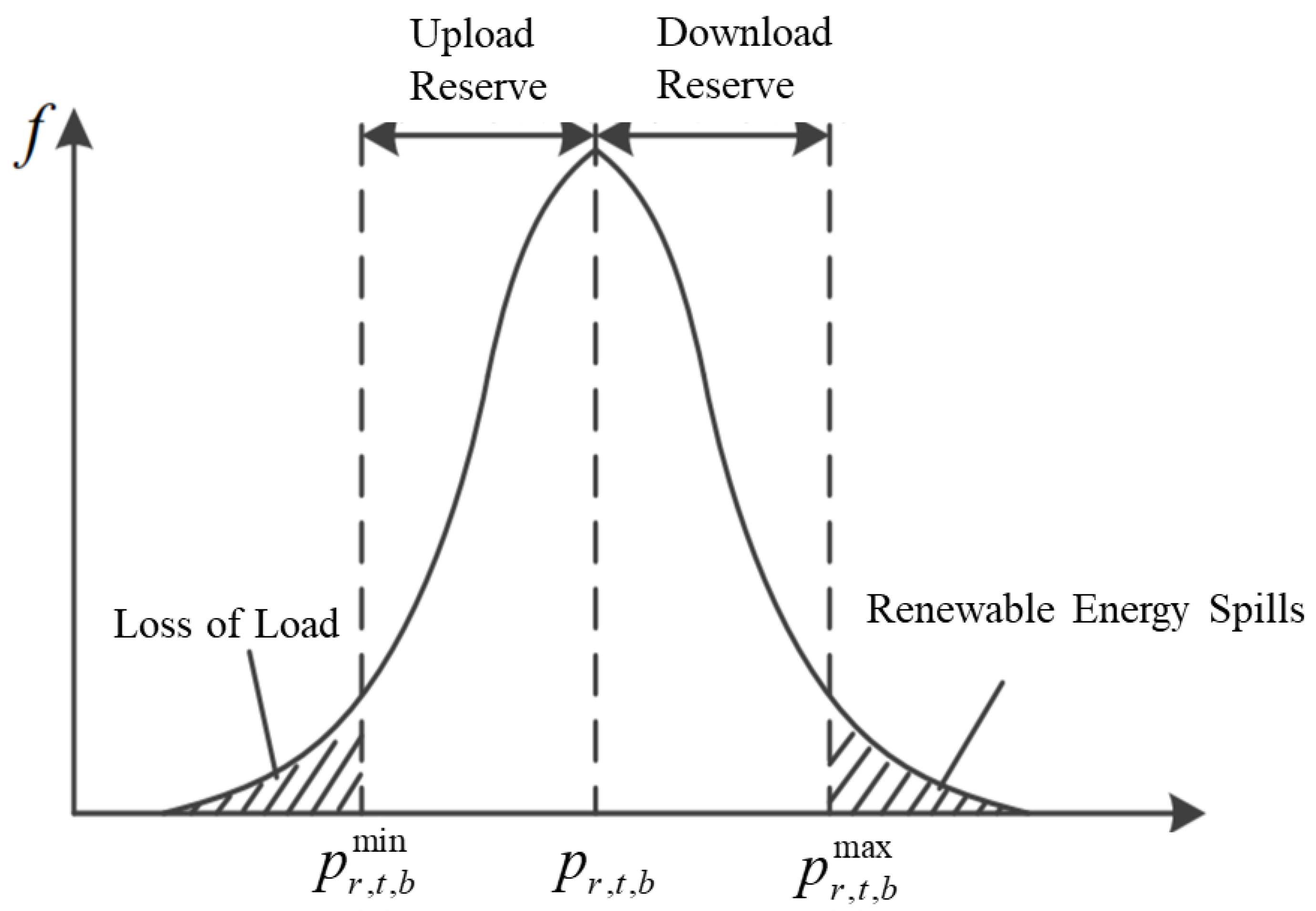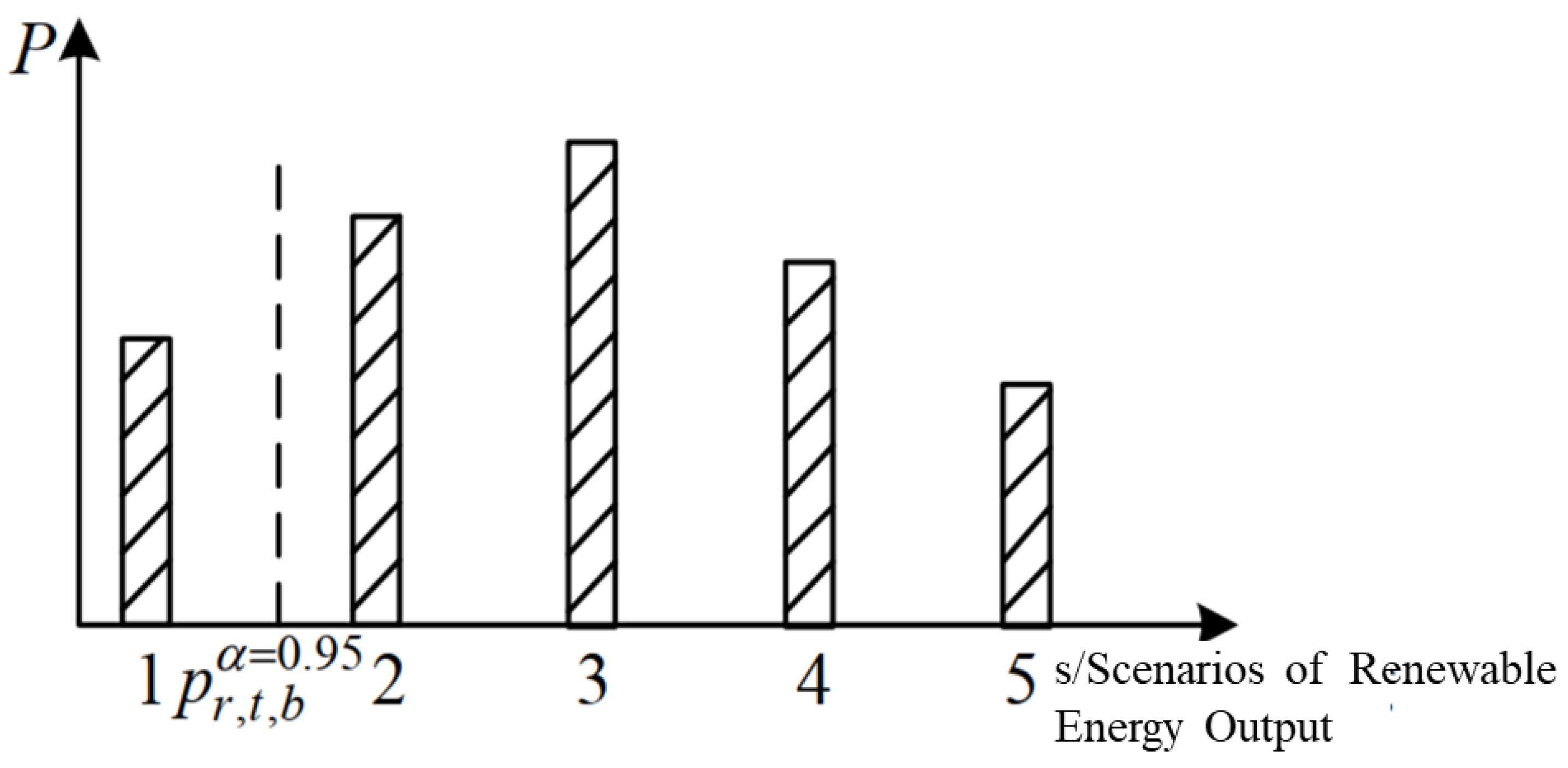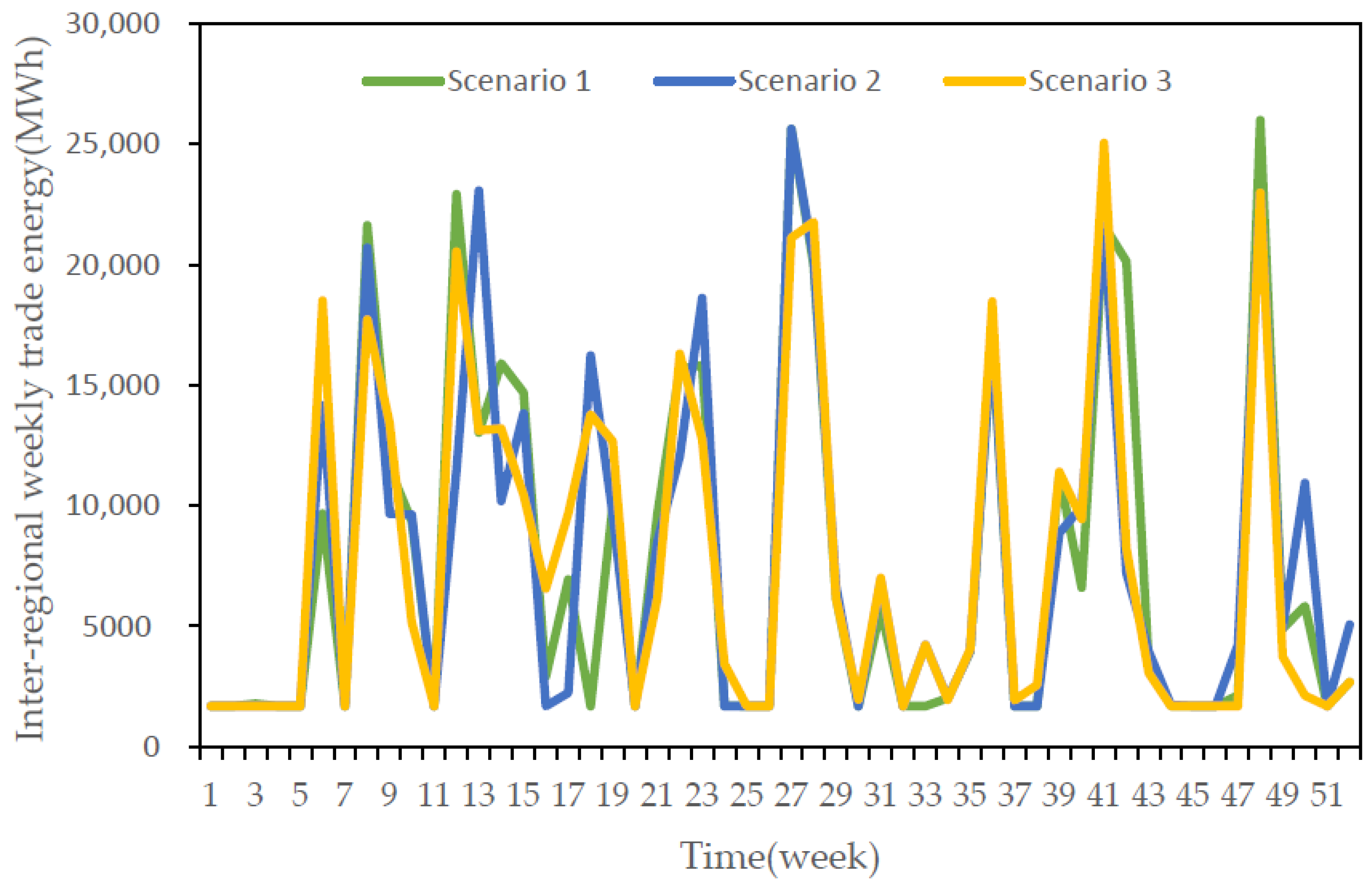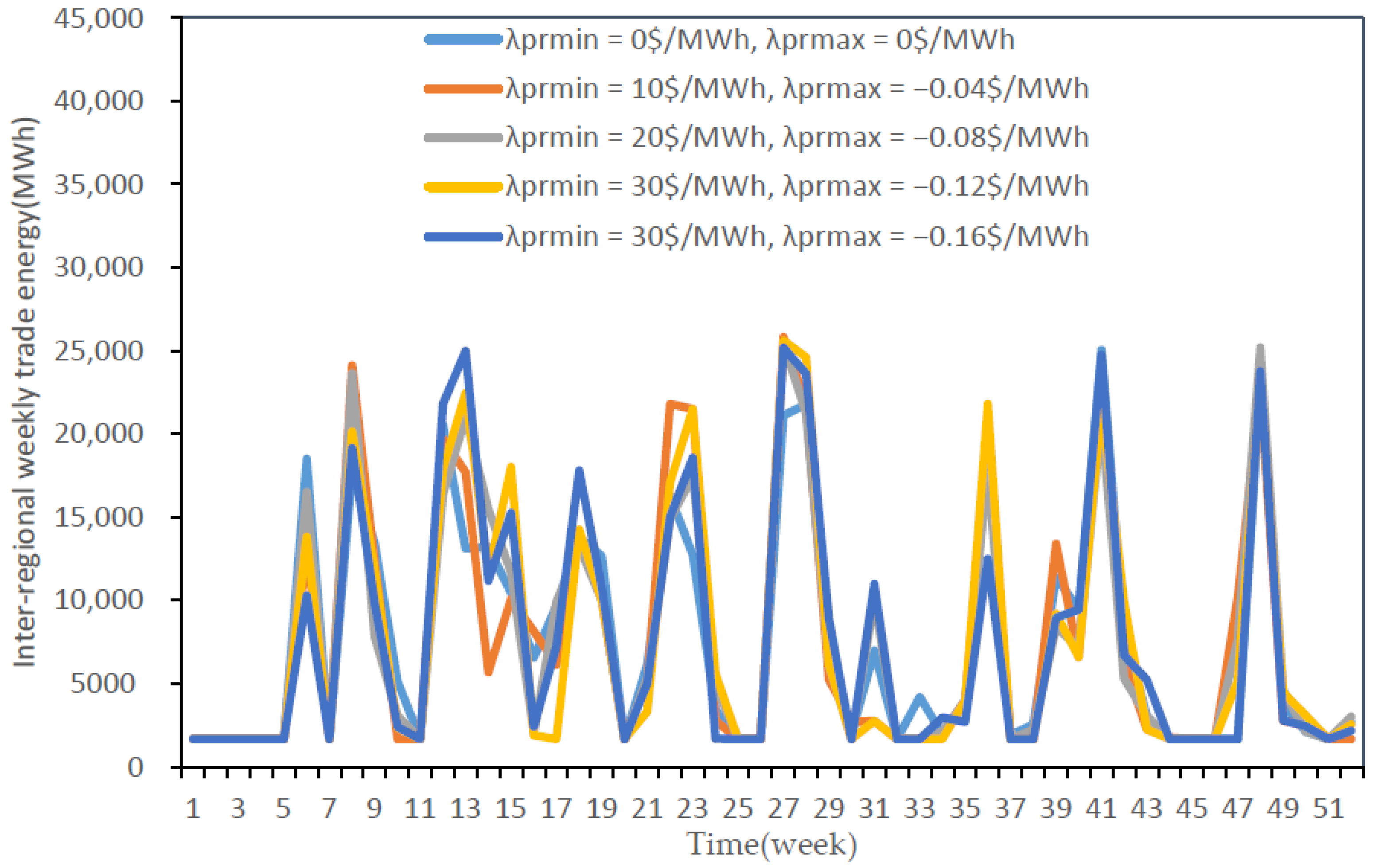A Mid/Long-Term Optimization Model of Power System Considering Cross-Regional Power Trade and Renewable Energy Absorption Interval
Abstract
:1. Introduction
- According to the seasonal characteristics of renewable energy output on medium-term and long-term scales, a scenario-based renewable energy output model is established, which can meet the needs of renewable energy data for medium- and long-term planning and operation. Using the concept of renewable energy consumption range, the renewable energy consumption is linked to the system regulation resources.
- Considering the pressure brought by the fluctuation of renewable energy output to the stable operation of the power system, this paper adds a penalty term for the renewable energy consumption interval to the objective function of the model, considering the economic impact of power system operation.
2. Load and Renewable Energy Power Model
2.1. Load Power Model
- According to the time series load curve, arrange the data in the load time series curve in descending order. Then, the accurate duration curve is obtained.
- Determine the number of load segments required for the model calculation and select the load level corresponding to each load segment to obtain an approximate load segment curve. It should be noted that the load block curve should reflect the maximum and minimum loads. Therefore, the number of load blocks is generally not less than three blocks.
- Appropriately adjust each load block to ensure the total power of approximate load block curve equals that of the original sequential load curve.
2.2. Renewable Energy Power Model
3. Model Description
3.1. Objective Function
3.2. Maintenance Constraints
3.3. Unit Operation Constraints
3.3.1. Renewable Energy Unit Power Output Constraints
3.3.2. Renewable Energy Expected Electric Energy Constraints
3.3.3. Renewable Energy Curtailment Constraints
3.3.4. Load Loss Constraints
3.4. Cross-regional Power Trade Constraints
3.4.1. Cross-Regional Trade Power Constraints
3.4.2. Cross-Regional Trade Energy Constraints
3.5. System Operation Constraints
3.5.1. Electric Power Balance Constraints
3.5.2. Electric Energy Balance Constraints
3.5.3. System Reserve Constraints
4. Case Studies
4.1. The Base Case
4.2. Analysis of the Influence of Quarterly Arrangements in Cross-Regional Power Trade
4.3. Analysis of the Influence of Tie-Line Power Range
4.4. Analysis of the Influence of Renewable Energy Absorption Interval Penalty Coefficient
5. Conclusions
Author Contributions
Funding
Institutional Review Board Statement
Informed Consent Statement
Data Availability Statement
Conflicts of Interest
References
- Abdmouleh, Z.; Alammari, R.A.M.; Gastli, A. Review of policies encouraging renewable energy integration & best practices. Renew. Sustain. Energy Rev. 2015, 45, 249–262. [Google Scholar]
- Hannele, H.; Peter, M.; Antje, O. Impacts of large amounts of wind power on design and operation of power systems, results of IEA collaboration. Wind Energy 2011, 14, 179–192. [Google Scholar]
- Bouffard, F.; Galiana, F.D. Stochastic security for operations planning with significant wind power generation. IEEE Trans. Power Syst. 2008, 23, 306–316. [Google Scholar] [CrossRef]
- Hu, B.; Lou, S.; Li, H.; Wu, Y.; Lu, S.; Huang, X. Spinning reserve demand estimation in power systems integrated with large-scale photovoltaic power plants. Autom. Electr. Power Syst. 2015, 39, 15–19. [Google Scholar]
- Bu, S.Q.; Du, W.; Wang, H.F. Probabilistic analysis of small-signal stability of large-scale power systems as affected by penetration of wind generation. IEEE Trans. Power Syst. 2012, 27, 762–770. [Google Scholar] [CrossRef]
- Gautam, D.; Goel, L.; Ayyanar, R. Control strategy to mitigate the impact of reduced inertia due to doubly fed induction generators on large power systems. IEEE Trans. Power Syst. 2011, 26, 214–224. [Google Scholar] [CrossRef]
- Shah, R.; Mithulananthan, N.; Bansal, R.C. A review of key power system stability challenges for large-scale PV integration. Renew. Sustain. Energy Rev. 2015, 41, 1423–1436. [Google Scholar] [CrossRef]
- Nichita, C.; Luca, D.; Dakyo, B. Large band simulation of the wind speed for real time wind turbine simulators. IEEE Power Eng. Rev. 2007, 22, 63. [Google Scholar] [CrossRef]
- Miranda, M.S.; Dunn, R.W. Spatially correlated wind speed modeling for generation adequacy studies in the UK. In Proceedings of the 2007 IEEE Power Engineering Society General Meeting, Tampa, FL, USA, 24–28 June 2007; pp. 1–6. [Google Scholar]
- Li, D.; Chen, C. Wind speed model for dynamic simulation of wind power generation system. Proc. CSEE 2005, 25, 41–44. [Google Scholar]
- Zhang, H.; Yin, Y.; Shen, H. A wind speed time series modeling method based on probability measure transformation. Autom. Electr. Power Syst. 2013, 37, 7–10. [Google Scholar]
- Philippopoulos, K.; Deligiorgi, D. Statistical simulation of wind speed in Athens, Greece based on Weibull and ARMA models. Int. J. Energy Environ. Econ. 2009, 3, 151–158. [Google Scholar]
- Doquet, M. Use of a stochastic process to sample wind power curves in planning studies. In Proceedings of the 2007 IEEE Lausanne Power Tech, Lausanne, Switzerland, 1–5 July 2007; pp. 663–670. [Google Scholar]
- Woods, M.J.; Russell, C.J.; Davy, R.J. Simulation of Wind Power at Several Locations Using a Measured Time-Series of Wind Speed. IEEE Trans. Power Syst. 2013, 28, 219–226. [Google Scholar] [CrossRef]
- Bibby, B.; Skovgaard, I.; Sorensen, M. Diffusion-type models with given marginals and auto-correlation function. Bernoulli 2005, 11, 191–220. [Google Scholar]
- Laslett, D.; Creagh, C.; Jennings, P. A simple hourly wind power simulation for the South-West region of Western Australia using MERRA data. Renew. Energy 2016, 96, 1003–1014. [Google Scholar] [CrossRef] [Green Version]
- Zou, J.; Lai, X.; Wang, N. Time series model of stochastic wind power generation. Power Syst. Technol. 2014, 38, 2416–2421. [Google Scholar]
- Chen, P.; Pedersen, T.; Bak-Jensen, B. ARIMA-Based time series model of stochastic wind power generation. IEEE Trans. Power Syst. 2010, 25, 667–676. [Google Scholar] [CrossRef] [Green Version]
- Papaefthymiou, G.; Klockl, B. MCMC for wind power simulation. IEEE Trans. Energy Convers. 2008, 23, 234–240. [Google Scholar] [CrossRef] [Green Version]
- Liu, C.; Lu, Z.; Huang, Y. A new method to simulate wind power time series of large time scale. Power Syst. Prot. Control. 2013, 41, 7–13. [Google Scholar]
- Li, C.; Liu, C.; Huang, Y. Study on the modeling method of wind power time series based on fluctuation characteristics. Power Syst. Technol. 2015, 39, 208–214. [Google Scholar]
- Denaxas, E.A.; Bandyopadhyay, R.; Patiño-Echeverri, D.; Pitsianis, N. SynTiSe: A modified multi-regime MCMC approach for generation of wind power synthetic time series. In Proceedings of the 2015 Annual IEEE Systems Conference (SysCon) Proceedings, Vancouver, BC, Canada, 13–16 April 2015; pp. 668–674. [Google Scholar]
- Brokish, K.; Kirtley, J. Pitfalls of modeling wind power using Markov chains. In Proceedings of the 2009 IEEE/PES Power Systems Conference and Exposition, Seattle, WA, USA, 15–18 March 2009; pp. 1–6. [Google Scholar]
- Yu, P.; Li, J.; Wen, J. A wind power time series modeling method based on its time domain characteristics. Proc. CSEE 2014, 34, 3715–3723. [Google Scholar]
- Li, J.; Zhu, D. Combination of moment-matching, Cholesky and clustering methods to approximate discrete probability distribution of multiple wind farms. IET Renew. Power Gener. 2015, 10, 1450–1458. [Google Scholar] [CrossRef]
- Lin, C.; Bie, Z.; Pan, C.; Liu, S. Fast cumulant method for probabilistic power flow considering the nonlinear relationship of wind power generation. IEEE Trans. Power Syst. 2020, 35, 2537–2548. [Google Scholar] [CrossRef]
- Pan, C.; Wang, C.; Zhao, Z.; Wang, J.; Bie, Z. A Copula function based monte carlo simulation method of multi-variate wind speed and PV power spatio-temporal series. Energy Procedia 2019, 159, 213–218. [Google Scholar] [CrossRef]
- Collares-Pereira, M.; Rabl, A. The average distribution of solar radiation-correlations between diffuse and hemispherical and between daily and hourly insolation values. Sol. Energy 1979, 22, 155–164. [Google Scholar] [CrossRef]
- Zhang, S.; Tian, S. The institution of the hourly solar radiation model. Acta Energ. Sol. Sin. 1997, 18, 273–277. [Google Scholar]
- Xu, Q.; Zang, H.; Bian, H. Establishment and feasibility researches of practical solar Radiation Model. Acta Energ. Sol. Sin. 2011, 32, 1180–1185. [Google Scholar]
- Rahman, S.; Khallat, M.A.; Salameh, Z.M. Characterization of insolation data for use in photovoltaic system analysis models. Energy 1988, 13, 63–72. [Google Scholar] [CrossRef]
- Karaki, S.H.; Chedid, R.B.; Ramadan, R. Probabilistic performance assessment of autonomous solar-wind energy conversion systems. IEEE Trans. Energy Convers. 1999, 14, 766–772. [Google Scholar] [CrossRef]
- Peng, C.; Huang, Y.; Wu, Z. Building-integrated photovoltaics (BIPV) in architectural design in China. Energy Build. 2011, 43, 3592–3598. [Google Scholar] [CrossRef]
- Tiwari, G.N.; Mishra, R.K.; Solanki, S.C. Photovoltaic modules and their applications: A review on thermal modelling. Appl. Energy 2011, 88, 2287–2304. [Google Scholar] [CrossRef]
- Sulaiman, M.Y.; Oo, W.M.H.; Wahab, M.A. Application of beta distribution model to Malaysian sunshine data. Renew. Energy 1999, 18, 573–579. [Google Scholar] [CrossRef]
- Klöckl, B.; Papaefthymiou, G. Multivariate time series models for studies on stochastic generators in power systems. Electr. Power Syst. Res. 2010, 80, 265–276. [Google Scholar] [CrossRef]
- Huang, R.; Huang, T.; Gadh, R. Solar generation prediction using the ARMA model in a laboratory-level micro-grid. In Proceedings of the IEEE Third International Conference on Smart Grid Communications, Tainan, Taiwan, 5–8 November 2012; pp. 528–533. [Google Scholar]
- Hassanzadeh, M.; Etezadi-Amoli, M.; Fadali, M.S. Practical approach for sub-hourly and hourly prediction of PV power output. In Proceedings of the North American Power Symposium, Arlington, TX, USA, 26–28 September 2010; pp. 1–5. [Google Scholar]
- Ding, M.; Xu, N. A method to forecast short-term output power of photovoltaic generation system based on Markov Chain. Power Syst. Technol. 2011, 35, 152–157. [Google Scholar]
- Li, R.; Li, G. Photovoltaic power generation output forecasting based on support vector machine regression technique. Electr. Power 2008, 41, 74–78. [Google Scholar]
- Zhong, H.; Xia, Q.; Ding, M.; Zhang, H. A new mode of HVDC tie-line operation for maximizing renewable energy accommodation. Autom. Electr. Power Syst. 2015, 39, 6–42. [Google Scholar]
- Xu, F.; Ding, Q.; Han, H.; Xie, L.; Lu, M. Power optimization and analysis of HVDC tie-line for promoting integration of cross-regional renewable energy accommodation. Autom. Electr. Power Syst. 2017, 41, 152–159. [Google Scholar]
- Cheng, X.; Cheng, C.; Shen, J.; Li, G.; Lu, J. Coordination and optimization methods for large-scale trans-regional hydro-power transmission via UHVDC in regional and provincial power grids. Autom. Electr. Power Syst. 2015, 39, 151–158. [Google Scholar]
- Ahmadi, A.; Conejo, A.J.; Cherkaoui, R. Multi-area energy and reserve dispatch under wind uncertainty and equipment failures. IEEE Trans. Power Syst. 2013, 28, 4373–4383. [Google Scholar] [CrossRef]
- Ahmadi, A.; Conejo, A.J.; Cherkaoui, R. Multi-area unit scheduling and reserve allocation under wind power uncertainty. IEEE Trans. Power Systems. 2014, 29, 1701–1710. [Google Scholar] [CrossRef]
- Frunt, J.; Kechroud, A.; Kling, W.L.; Myrzik, J.M.A. Participation of distributed generation in balance management. In Proceedings of the IEEE/PES Power Tech 2009, Bucharest, Romania, 28 June–2 July 2009; Piscataway: Institute of Electrical and Electronics Engineers: Bucharest, Romania, 2009; pp. 1–6. [Google Scholar]
- Jiang, R.; Wang, J.; Guan, Y. Robust unit commitment with wind power and pumped storage hydro. IEEE Trans. Power Syst. 2012, 27, 800–810. [Google Scholar] [CrossRef]
- Xu, Q.; Deng, C.; Zhao, W. A multi-scenario robust dispatch method for power grid integrated with wind farms. Power Syst. Technol. 2014, 38, 653–661. [Google Scholar]
- Wu, W.; Chen, J.; Zhang, B. A robust wind power optimization method for look-ahead power dispatch. IEEE Trans. Sustain. Energy 2014, 5, 507–515. [Google Scholar] [CrossRef]
- Chen, J.; Wu, W.; Zhang, B. A robust interval wind power dispatch method considering the tradeoff between security and economy. Proc. CSEE 2014, 34, 1033–1040. [Google Scholar]
- Li, Z.; Wu, W.; Zhang, B. A robust interval economic dispatch method accommodating large-scale wind power generation part one dispatch scheme and mathematical model. Autom. Electr. Power Syst. 2014, 38, 33–39. [Google Scholar]
- Sial, A.; Singh, A.; Mahanti, A. Detecting anomalous energy consumption using contextual analysis of smart meter data. Wirel. Netw. 2021, 27, 4275–4292. [Google Scholar] [CrossRef]
- Sial, A.; Singh, A.; Mahanti, A.; Gong, M. Heuristics-Based detection of abnormal energy consumption. In Lecture Notes of the Institute for Computer Sciences, Social Informatics and Telecommunications Engineering; Chong, P., Seet, B.C., Chai, M., Rehman, S., Eds.; Smart Grid and Innovative Frontiers in Telecommunications; Smart GIFT 2018; Springer: Cham, Switzerland, 2018; Volume 245. [Google Scholar]
- Sial, A.; Jain, A.; Singh, A.; Mahanti, A. Profiling energy consumption in a residential campus. In Proceedings of the 2014 CoNEXT on Student Workshop (CoNEXT Student Workshop’14), Sydney, Australia, 2 December 2014; Association for Computing Machinery: New York, NY, USA, 2014; pp. 15–17. [Google Scholar]
- Shao, C.; Wang, Y.; Feng, C.; Wang, X.; Wang, B. Mid/long-term power system production simulation considering multi-energy generation. Proc. CSEE 2020, 40, 4072–4081. [Google Scholar]
- Xu, J.; Yi, X.K.; Sun, Y.Z. Stochastic optimal scheduling based on scenario analysis for wind farms. IEEE Trans. Sustain. Energy. 2017, 8, 1548–1559. [Google Scholar] [CrossRef]
- Feng, C.Y.; Wang, X.F. Review of generator maintenance scheduling in power market. Autom. Electr. Power Syst. 2007, 31, 97–104. [Google Scholar]
- Wang, Y.; Shao, C.; Sun, P.; Wang, X.; Wang, X.; Li, D. Generator maintenance schedule considering characteristics of multi-type renewable energy. In Proceedings of the 2018 International Conference on Power System Technology (POWERCON), Guangzhou, China, 6–8 November 2018; pp. 4050–4055. [Google Scholar]
- Ma, X.; Zhang, Z.; Bai, B.; Ren, X.; Kang, K. Mid/long-term power system operation model considering inter-regional power trade. In Proceedings of the 2021 IEEE 2nd China International Youth Conference on Electrical Engineering (CIYCEE), Chengdu, China, 15–17 December 2021; pp. 1–6. [Google Scholar]
- Probability Methods Subcommittee. IEEE reliability test system. IEEE Trans. Power Appar. Syst. 1979, 98, 2047–2054. [Google Scholar]
- Wang, S.J.; Shahidehpour, S.M.; Kirschen, D.S.; Mokhtari, S.; Irisarri, G.D. Short-term generation scheduling with transmission and environmental constraints using an augmented Lagrangian relaxation. IEEE Trans. Power Syst. 1995, 10, 1294–1301. [Google Scholar] [CrossRef]






| Reference No. | Method |
|---|---|
| [8,16] | Von Karman |
| [9,17] | AutoRegressive (AR) |
| [10,11,12,18] | AutoRegressive Moving Average (ARMA) |
| [13,14,15] | Stochastic Differential Equations |
| [19,20,21,22,23,24] | Markov Chain Monte Carlo (MCMC) |
| [12,25,26,27] | Copula function |
| Reference No. | Method |
|---|---|
| [28] | Collares-Pereira and Rabl (C-P&R) |
| [29] | Half-Sine |
| [30] | Parabolic |
| [31,32,33,34,35] | Beta Distribution |
| [36] | AutoRegressive (AR) |
| [37] | AutoRegressive Moving Average (ARMA) |
| [38] | Sinusoidal |
| [39] | Markov |
| [40] | Support Vector Machine |
| Total Thermal Power Cost (107 $) | Per Thermal Power Cost ($/MWh) | Probability of Renewable Energy Spills (%) |
|---|---|---|
| 6.3908 | 12.5369 | 5.6833 |
| Scenario | Total Thermal Power Cost (107 $) | Per Thermal Power Cost ($/MWh) | Probability of Renewable Energy Spills (%) |
|---|---|---|---|
| 1 | 6.2551 | 12.6416 | 4.6579 |
| 2 | 6.2772 | 12.7028 | 4.5779 |
| 3 | 6.2488 | 12.6589 | 4.4791 |
| Tie-Line Power Range | Total Thermal Power Cost (107$) | Per Thermal Power Cost ($/MWh) | Probability of Renewable Energy Spills (%) |
|---|---|---|---|
| [1, 1] | 6.2488 | 12.6589 | 4.4791 |
| [0.9, 1.1] | 6.2571 | 12.6747 | 4.5031 |
| [0.7, 1.3] | 6.2271 | 12.5792 | 4.6441 |
| [0.5, 1.5] | 6.2384 | 12.7315 | 4.1430 |
| Renewable Energy Absorption Interval Cost | Total Thermal Power Cost (107$) | Per Thermal Power Cost ($/MWh) | Probability of Renewable Energy Spills (%) |
|---|---|---|---|
| λprmin = 0 $/MWh λprmax = 0 $/MWh | 6.2488 | 12.6589 | 4.4791 |
| λprmin = 10 $/MWh λprmax = −0.04 $/MWh | 6.2605 | 12.6816 | 4.5230 |
| λprmin = 20 $/MWh λprmax = −0.08 $/MWh | 6.2610 | 12.6919 | 4.4627 |
| λprmin = 30 $/MWh λprmax = −0.12 $/MWh | 6.2529 | 12.6824 | 4.4585 |
| λprmin = 30 $/MWh λprmax = −0.16 $/MWh | 6.2487 | 12.6700 | 4.4410 |
Publisher’s Note: MDPI stays neutral with regard to jurisdictional claims in published maps and institutional affiliations. |
© 2022 by the authors. Licensee MDPI, Basel, Switzerland. This article is an open access article distributed under the terms and conditions of the Creative Commons Attribution (CC BY) license (https://creativecommons.org/licenses/by/4.0/).
Share and Cite
Ma, X.; Zhang, Z.; Bai, H.; Ren, J.; Cheng, S.; Kang, X. A Mid/Long-Term Optimization Model of Power System Considering Cross-Regional Power Trade and Renewable Energy Absorption Interval. Energies 2022, 15, 3594. https://doi.org/10.3390/en15103594
Ma X, Zhang Z, Bai H, Ren J, Cheng S, Kang X. A Mid/Long-Term Optimization Model of Power System Considering Cross-Regional Power Trade and Renewable Energy Absorption Interval. Energies. 2022; 15(10):3594. https://doi.org/10.3390/en15103594
Chicago/Turabian StyleMa, Xiaowei, Zhiren Zhang, Hewen Bai, Jing Ren, Song Cheng, and Xiaoning Kang. 2022. "A Mid/Long-Term Optimization Model of Power System Considering Cross-Regional Power Trade and Renewable Energy Absorption Interval" Energies 15, no. 10: 3594. https://doi.org/10.3390/en15103594
APA StyleMa, X., Zhang, Z., Bai, H., Ren, J., Cheng, S., & Kang, X. (2022). A Mid/Long-Term Optimization Model of Power System Considering Cross-Regional Power Trade and Renewable Energy Absorption Interval. Energies, 15(10), 3594. https://doi.org/10.3390/en15103594







